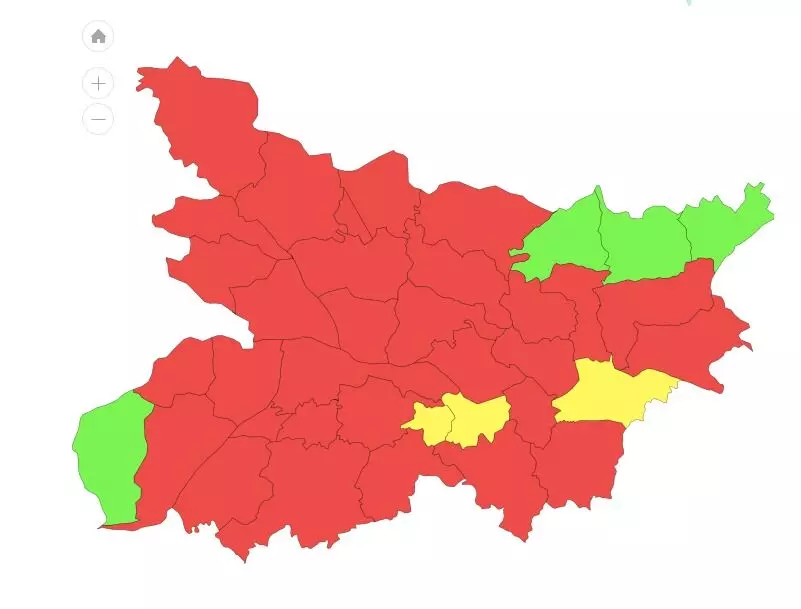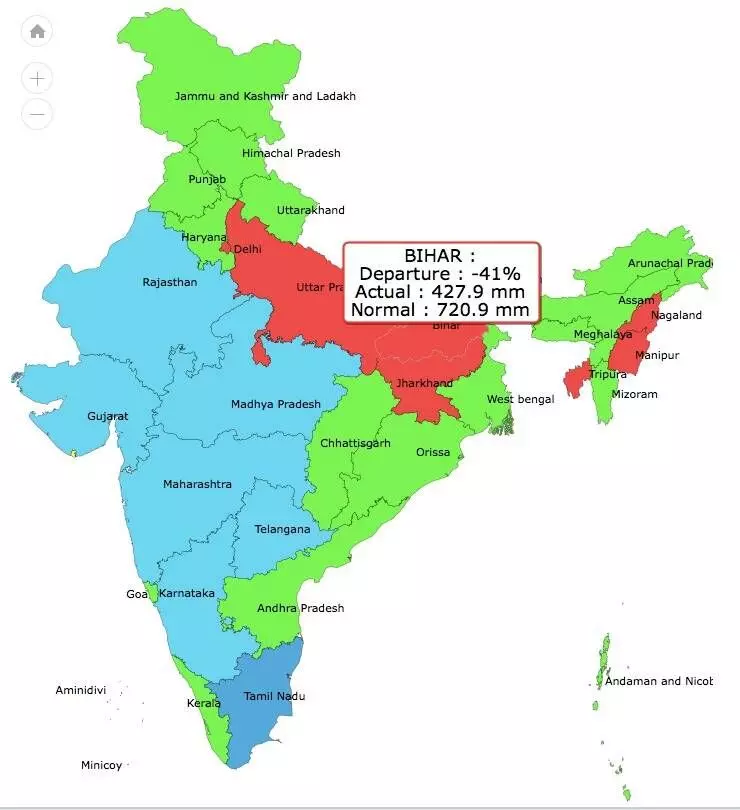Bhagalpur, Bihar
Staring hopelessly at his two bighas [half an hectare] of agricultural land, Mukesh Mishra, a 41-year-old paddy farmer from Bihar’s Bhagalpur district, is in low spirits.
“It has barely rained this year. The groundwater level is also low and the cost of boring a tubewell is not affordable for small farmers like me,” Mishra, a resident of Chakrami village, told Gaon Connection. “Sensing that the Indradev [god of rain] is not blessing us this year, I planted paddy on less than half of my land. Even then, there is a considerable risk of my paddy crop failing this year,” he added.
Shambhu Khan, a resident of the neighbouring Jairampur village, shares Mishra’s plight. “The monsoon has betrayed us this year. We are desperate for the rains else we will have no grain of rice to harvest. Farmers like us will be ruined,” he said.
Over 200 kilometres away, paddy farmers in Madhubani district are watching their paddy seedlings wilt and dry. “During this time of the year, the paddy fields used to be so deeply submerged in water that it was difficult to enter them. The paddy used to be above knee-length, but look at it this year! Because of scanty rainfall, the paddy is still of the same size as I had sown it weeks ago,” Pankaj Ray, a farmer from Madhepur block in Madhubani, told Gaon Connection.

Despite large scale deficient rainfall and growing angst of the farmers, the state government is yet to declare drought and roll out drought relief measures. (File picture)
Bihar, India’s most flood-prone state and one of the key paddy growing states, has been facing drought conditions in the southwest monsoon season this year.
As of August 24, the state has a deficient monsoon rainfall of minus 41 per cent, as recorded by the India Meteorological Department (IMD). Between June 1 and August 24 this year, as against its normal rainfall of 720.9 millimetres (mm), the state has recorded 427.9 mm rainfall only.
The situation seems critical across the state as of the total 38 districts in Bihar, only four have reported ‘normal’ monsoon rainfall, so far. All the other districts have reported ‘deficient’ or ‘large deficient’ rainfall (See map: District-wise monsoon rainfall in Bihar June 1- August 24, 2022)

Despite large scale deficient rainfall and growing angst of the farmers, the state government is yet to declare drought and roll out drought relief measures.
“There is no plan to declare drought as of now,” Ravindra Kumar, officer on special duty at the Bihar State Disaster Management Authority (BSDMA), told Gaon Connection.
“The Bihar government is working on providing alternative farming to farmers reeling under drought like conditions.Floods and drought hit the state at regular intervals.The irrigation department is also trying to provide water to the farmers,” he added.
Expressing his protest against the state government’s refusal to officially declare a drought this year, Kamal Nayan, a farmers’ leader and the president of Katarni Chawal Sangh told Gaon Connection that the government needs to declare drought at the earliest and make arrangements to compensate the farmers for their upcoming losses.
“A vast majority of paddy farmers in Bihar are dependent on the rains for their successful produce. In such a situation, the government should declare a drought as early as possible but it is seen that the government is only indulging in coalition politics and trying to secure its power anyhow,” the Bhagalpur-based farmers’ leader said.
“If the government doesn’t wake up on time, there will be a serious crisis this year which will affect uncountable lives,” Nayan added.
Paddy Pain, a Gaon Connection series
As part of our new series – Paddy Pain – Gaon Connection reporters travelled across the key paddy producing states to document the impact of deficient monsoon rainfall on the paddy crop this year. And the reports they have come back with seem worrisome, as paddy farmers are reportedly staring at huge crop losses.
The first story of the ‘Paddy Pain’ series was from Uttar Pradesh; the second from West Bengal; the third from Bangladesh; followed by a ground report from Jharkhand. This story from Bihar is the fifth in the series.
Incidentally, these drought conditions prevail in the states in the Indo-Gangetic plains. For instance, Uttar Pradesh has reported the highest rainfall deficit in this monsoon season so far — minus 44 per cent — followed by Bihar at minus 41 per cent. Jharkhand too, has deficient rainfall of minus 27 per cent and Delhi has recorded a deficient rainfall of minus 28 per cent (see map: State-wise monsoon rainfall in India; Jine 1 to August 24, 2022).

Note: Red: Deficient (-59% to -20%), Green: Normal (-19% to 19%), Blue: Excess (20% to 59%), Dark blue: Large excess: 60% or more.
Meanwhile, in the northeast region, three states have reported deficient monsoon rainfall — Manipur (minus 44 per cent), Tripura (minus 26 per cent) and Nagaland (minus 20 per cent).
In Bhagalpur district of Bihar, from where Mukesh Mishra and Shambhu Khan hail, rainfall departure stands at minus 63 per cent (as of August 24), which is categorised as ‘large deficient’ rainfall.
CM Nitish Kumar reviews situation
With large swathes of the state reeling under deficient rainfall, Chief Minister Nitish Kumar conducted an aerial survey of the ‘drought-like conditions’ in the state on August 19.
“The situation of drought has come due to the apathy of the monsoon this year. The rainfall was 60 per cent below the average across the state in July due to which sowing of crops could not be done on time,” the chief minister was quoted.
Following the aerial survey, the chief minister’s office released a press statement on August 20 in which it was stated that the officials have been directed to take necessary measures to provide respite to the farmers who are battling drought-like conditions in the state.

Chief Minister Nitish Kumar conducted an aerial survey of the ‘drought-like conditions’ in the state on August 19.
Also Read: Fear of drought looms large over Bundelkhand; paddy and pulses crops affected
“The chief minister has directed the officials to ensure irrigation facilities for the farmers so that their crops don’t fail. The officials have been asked to monitor the rainfall in the state and provide every possible assistance to the cultivation in the wake of drought-like conditions. Farmers should be provided with at least 16 hours of uninterrupted electricity to ensure irrigation facilities which will protect the paddy crop from failing,” the press statement read.
“Also, alternative seeds should be provided to the farmers at the earliest so as to ensure that they can save their losses,” it added.
However, Shambhu Khan, the paddy farmer from Bhagalpur isn’t pleased with these official announcements.
“A lot more needs to be done than this, the announcements come and go but their implementation hardly ever benefits us. A compensation will be the most effective way to benefit farmers like me,” he said.




















